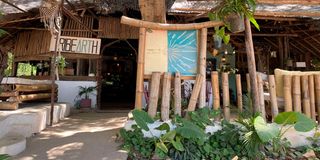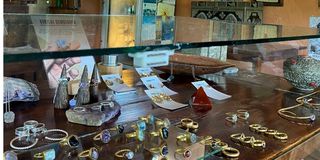Premium
The vegan boutique tucked away in Diani

It is to die for – the mango puree in the baobab seed pod patterned with grated coconut, chia and pumpkin seeds with a pop of a maroon bougainvillea flower. On a hot coastal day, it’s refreshingly cool after gaping at this culinary artwork in the seed pod of Africa’s oldest living monument, the baobab tree.
Tribearth is no ordinary address. But appearances can be deceptive.
It is a roadside shack with a Rasta flag stirred by the breeze – in a word, nondescript – by a wizened baobab, under a makuti roof with locally woven mats and oriental rugs spread on the sand floor and basic wooden furniture topped with cushions in colourful khanga prints. The walls feature art by local artists and the area showcasing its signature jewellery is lit softly with eastern lamps and fabricated in-house by local artisans in the adjoining workshop.
“We use smelted metal from things like old locks and padlocks for the jewellery,” says Libosso Embukani of Tribearth, pointing to the kiln.

Tribearth resonates in things supporting local communities like the Shimoni women on the mainland across from Wasini Island who farm seaweed and turn it into body soap, no chemicals added. Being kind to yourself is as much a deal as being kind to Mother Earth and ‘kind cosmetics’ like these are my thing because the cosmetic industry is one of the biggest pollutant.
From the seaweed, it’s to the baobab featured on the menu by the shelf of things Ethiopian…the coffee, scent and cuisine, everything vegan, cooked using no animal fat.
Inspired by Middle Eastern and African dishes with the classic Ethiopian Injera, we dig into the feast. The injera arrives on an enormous circular platter, an Ethiopian fermented flatbread made from teff flour (it’s gluten free) which is a super-healthy grain, power-packed with complete proteins, iron, calcium and magnesium and more fibre per serving than any other grain.
It’s a communal food shared by the diners, spongy and slightly sour the way I like it. Sharing food from a common platter may be frowned upon in our over-sanitised world today, but there’s protocol with injera.
Hands washed, each tears the soft bread from her or his side to scoop the foods displayed on it. It’s like an artist’s paint palette…the red of the beetroot that’s the most delicious I’ve ever tasted, the green of the sukuma, orange lentils and more. In no time, the platter’s swiped clean by everyone on the table for what was supposed to be a platter for two.
There’s more to be surprised by. The biggest and cheapest samosa ever, the size of a side dish, is a meal in itself filled with all veggies for Sh250. The potato wedges served on a wooden platter with a tangy twist of lime is a happy go-around for all.
I ask Libosso why he turned vegan. Supporting short dreadlocks and so soft-spoken that I’m sure he couldn’t hurt a fly, he replies, “I was shocked after I watched a documentary on the meat industry in 2020 and saw how animals were being force-fed to fatten up for meat and milk and how the Amazon rain forest was being cleared for these enormous animal farms.

In Kenya people are also keeping lots of chicken, cows and other animals for meat in inhumane ways. It’s not respecting animals’ rights. That was the turning point for me and I turned vegan.”
Today the vegan movement is gaining momentum with more people becoming aware why it’s important to be kind to animals. Stressed animals suffer from the breakdown of glycogen that produces lactic acid resulting in not the healthiest of meats. So, caring for the earth and the food we eat is good and healthy for all.




